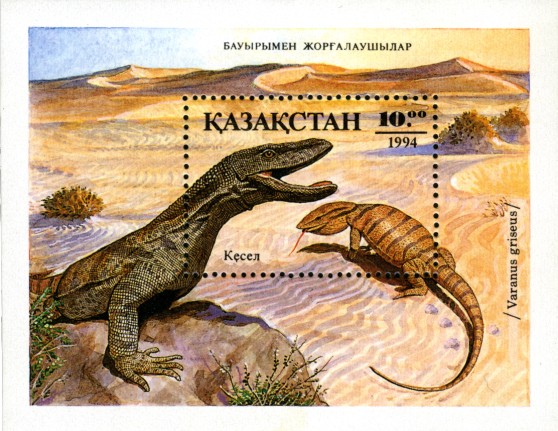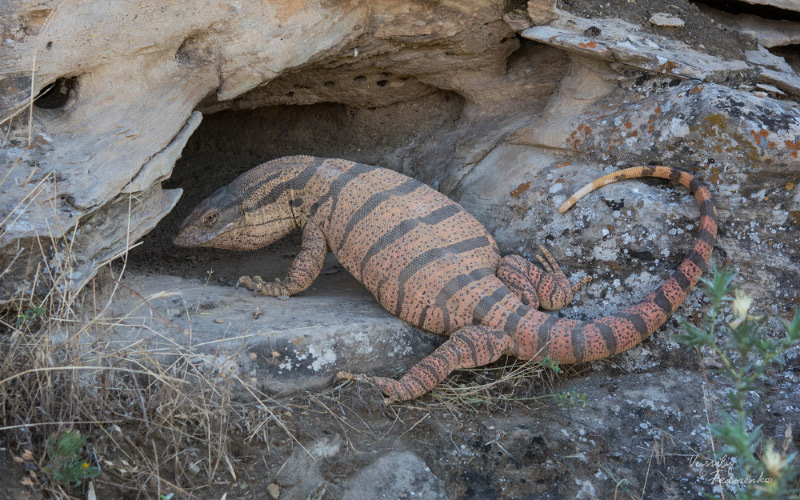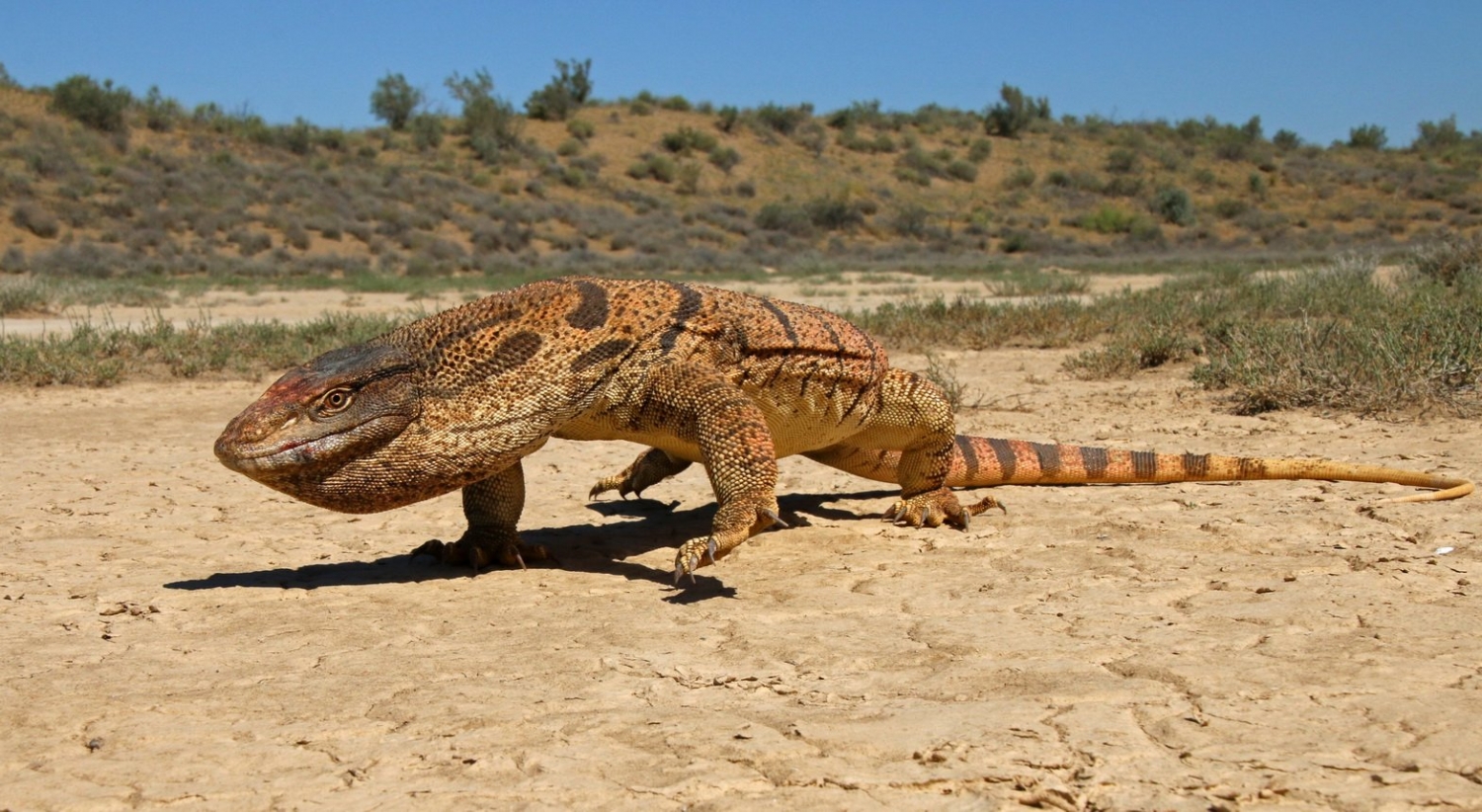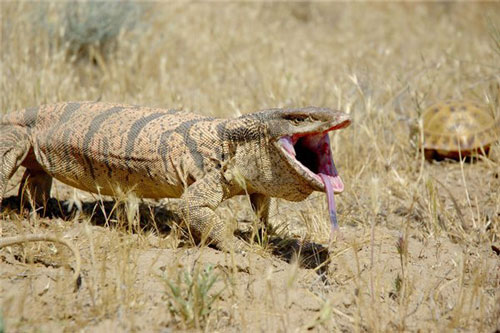 GREY MONITOR LIZARD
GREY MONITOR LIZARD
Distribution
The Central Asian grey monitor lizard is widespread in Central Asia, Azerbaijan, Pakistan, Turkey, Iran and Afghanistan. The northern border of the range reaches the coast of the Aral Sea and the southern chinks of Ustyurt and generally coincides with the border of the southern deserts. In the west, the area is limited to the coast of the Caspian Sea. In the east, along the Syr Darya Valley, the gray monitor lizard penetrates into the Fergana Valley (where it is now extremely rare or disappeared), and along the Amu Darya Valley, its range reaches southwestern Tajikistan.
Central Asian gray monitor lizards live in large numbers in places that abound with small mammals. A density of 9-12 individuals per 1 km2 was noted on the edge of Karabil, near Karamet-Niyaz (Turkmenistan) and in the Khuh Valley (Uzbekistan), 5 individuals per 1 km2 in the south-east of Turkmenistan and 3-5 individuals per 1 km2 in the clay deserts around Kara-Kala. But for the most part of the range, the number is estimated at 2-3 lizards per 1 km2, and in river valleys it drops to 1-1.5 individuals per 1 km2.
 Appearance
Appearance
Large individuals can reach a length of 1.5 m (of which about 60 cm falls on the body length and 90 cm on the tail) and weights up to 3-3.5 kg. But most adult monitor lizards are significantly smaller. Males are usually longer than females (the largest male from Turkmenistan, included in the sample in 1981, had a length of 58.5 cm without tail, and the largest female reached only 46 cm in length without tail), but not much heavier than them (the heaviest male weighed in this sample had a weight of 2,850 g, while female — 2,700 g).
The upper side of the body of adult Central Asian gray monitor lizards is colored reddish-brown or grayish with numerous small dark spots and specks. There are 2-3 dark longitudinal stripes on the upper side of the neck, which are usually connected at the back, forming a horseshoe-shaped pattern. There are 5-8 transverse dark brown stripes on the back, 13-19 transverse stripes forming rings on the tail. Young monitor lizards are more brightly colored, their dark stripes are dark brown, almost black, standing out sharply against the grayish-yellow general background.
The nostril is oblique, slit-shaped, located closer to the eye than to the end of the muzzle. The scales of the dorsal side of the body with blunt ribs, the abdominal shields are smooth. On the upper side of the neck, the scales are conical. There are approximately 143 rows of scales around the middle of the body. The length of the tail is 118-127% of the body length from the tip of the muzzle to the cloaca. Paws are characteristically short. The tail is rounded in cross-section at the base and somewhat compressed laterally in the rear, which also distinguishes it from other subspecies of the gray monitor lizard, in which the tail is practically not compressed laterally.
 Behavior and nutrition
Behavior and nutrition
The Central Asian gray monitor lizard lives in deserts and semi—deserts, mainly on fixed and semi-fixed sands, less often on clay soils. It is found in river valleys, foothills, ravines, tugai thickets. They avoid areas with dense vegetation, but sometimes visit sparse woodlands. These monitor lizards are usually very rare in places adjacent to human habitation, however, they are sometimes found on the outskirts of agricultural land.
As shelters, it uses burrows of rodents, birds, turtles and other animals, which, if necessary, expands and deepens, this is especially true in clay deserts, where it can be very problematic to dig holes for a monitor lizard on its own. In the sandy desert, Central Asian gray monitor lizards can dig their own burrows from 3-4 to 5 m deep and up to 50-120 cm deep. The burrow usually ends with an expanded chamber up to 0.5 m long and 10-12 cm wide . In abandoned settlements, they often populate cracks in adobe houses. For the winter, gray monitor lizards hibernate, hiding in burrows, the entrance to which is closed with an earthen plug. Wintering shelters are not always located in the summer habitat area and are usually located in bushes, rather than in an open area. After wintering, they appear in March—April.
The monitor lizard is active during the day, although it tries to avoid extreme heat. The normal body temperature of an active monitor lizard is 31.7-40.6 degrees. Every day, in search of food, the Central Asian gray monitor lizard overcomes long distances and can move away from the shelter by more than half a kilometer, passing more than 10 km a day. The gray monitor lizard is able to climb low trees, sometimes enters the water. These lizards are territorial, although their extensive individual areas (over 1 km2) can sometimes overlap.
The grey monitor lizard feeds on various vertebrates and invertebrates. Adults hunt mainly various rodents: gerbils, voles, mice, ground squirrels, jerboa.
Reptiles often become the prey of the monitor lizard: agamas, skinks, geckos, young turtles, snakes (including poisonous ones). There have been cases of grey monitor lizards eating large gyurz, Central Asian cobras and runners with a length of more than 140 cm. When hunting large snakes, the monitor lizard first tires the snake with false attacks and visits from different sides — just like mongooses do. Then, in a precise throw, he grabs the snake by the head or slightly behind, shakes it, hits the ground or rocks, or simply holds it and squeezes it with his teeth until it stops resisting. At the same time, the bites of venomous snakes do not have a visible effect on the monitor lizard, and it easily evades twisting the body rings of strangler snakes. Also, gray monitor lizards sometimes eat young hares that are not fast enough to escape from a predator, young hedgehogs and other small animals, toads, various birds, bird eggs or turtles. Monitor lizards living near permanent reservoirs, on occasion, eat frogs and freshwater crabs.
 Young monitor lizards and medium-sized individuals often hunt insects (mainly large beetles and locusts), scorpions, and solpugs. They do not disdain carrion.
Young monitor lizards and medium-sized individuals often hunt insects (mainly large beetles and locusts), scorpions, and solpugs. They do not disdain carrion.
When hunting, the monitor lizard adheres to approximately the same route, systematically examining colonies of gerbils, burrows, nests of birds. Most prey species are killed by vigorous shaking and compression of jaws equipped with sharp teeth. Despite the fact that the teeth of the gray monitor lizard do not bear cutting edges, unlike the sawtooth teeth of some other species of monitor lizards, they are able to kill and eat relatively large animals, often swallowing them whole with great effort.
Gray monitor lizards reach sexual maturity around the third year of life. During the mating period, which lasts very short, ritual fights can occur between males. Many Central Asian gray monitor lizards have noticeable scars on their backs, which were previously interpreted as the results of unsuccessful attacks by large birds of prey, but now it is considered that these wounds are usually received by monitor lizards during these very ritual fights, when two males stand on their hind legs, lean on each other and scratch with their claws.
 In Central Asia, monitor lizards mate in April and May. When mating, the male rubs his muzzle and underside of his body against the female. The female in June—early July begins to build a nest, which takes up to a week to build, and eventually lays 6-23 eggs (up to a maximum of 34) measuring 18—22x40—55 mm and weighing no more than 32-35 g. The eggs are guarded by females for several weeks and it has been recorded how females sometimes returned to their nests even at a later date. Young monitor lizards appear at the end of August—September and often immediately go into hibernation near the nest.
In Central Asia, monitor lizards mate in April and May. When mating, the male rubs his muzzle and underside of his body against the female. The female in June—early July begins to build a nest, which takes up to a week to build, and eventually lays 6-23 eggs (up to a maximum of 34) measuring 18—22x40—55 mm and weighing no more than 32-35 g. The eggs are guarded by females for several weeks and it has been recorded how females sometimes returned to their nests even at a later date. Young monitor lizards appear at the end of August—September and often immediately go into hibernation near the nest.
 Enemies
Enemies
Adult monitor lizards have practically no natural enemies, with the exception of humans. But young lizards can become victims of such predators as korsak, jackal, snake-eater, barrow, black kite. At times they are also attacked by their larger relatives. If a monitor lizard notices danger from a considerable distance, then it tries to escape, while at short distances it is able to reach speeds of up to 20 km / h. If it is not possible to escape from the enemy or the monitor lizard is caught by surprise, then it takes a characteristic threatening pose: it inflates the body, becoming wide and flat, hisses, opens its mouth and sticks its tongue out far. If the enemy comes closer, the monitor lizard lashes its tail strongly, makes bold throws towards the aggressor and can bite. Grey monitor lizard bites are very painful and sometimes accompanied by a local inflammatory reaction. This may be due to the presence of certain toxic components in the lizard's saliva.

 Dear visitors of the site of the "Kazavialesoohrana", at the moment there is an update of the design of the site (versions for the visually impaired), changing its styles. Work on the restyling of the site has been underway since 2022. The launch will take place in 2023. The templates will be translated into the state and English languages in stages. We hope you enjoy the new design.
Dear visitors of the site of the "Kazavialesoohrana", at the moment there is an update of the design of the site (versions for the visually impaired), changing its styles. Work on the restyling of the site has been underway since 2022. The launch will take place in 2023. The templates will be translated into the state and English languages in stages. We hope you enjoy the new design.











